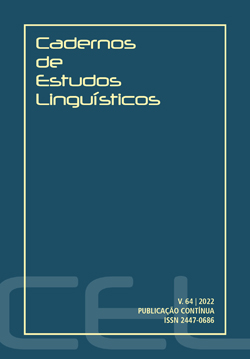Abstract
In this paper, we discuss an aspect of nominals in the subject position in pancake sentences in Brazilian Portuguese. Descriptively, pancake sentences have two main characteristics in Portuguese: (i) a noun in the subject position which is smaller than a full DP is interpreted as a situation; (ii) the predicate does not agree with the subject. This can be exemplified by the sentence Panqueca é bom (i.e. Pancake-fem is good-masc). Recent studies on this subject (SIQUEIRA, 2017, SIQUEIRA, SIBALDO & SEDRINS, 2020) argue that a further characteristic should be added to the description of pancake sentences in this language: that a nominal in the subject position allows for a determiner, e.g. A panqueca é bom (i.e. The-fem pancake-fem is good-masc). We show that sentences like A panqueca é bom are actually a case of verbal ellipsis. These sentences are only grammatical when they have an antecedent in a previous clause; they are impossible in out-of-the-blue contexts. By contrast, pancake sentences are possible in a context where only a pragmatic antecedent is present. Thus, pancake sentences contain deep anaphors in their syntactic structure. When the two sentence types, with and without a definite determiner, are inspected in light of the dichotomy between deep and superficial anaphor, it becomes clear that Panqueca é bom has a fundamentally different syntactic structure from A panqueca é bom. We show that only the former is a real pancake sentence.
References
ADLI, A. Gradedness and consistency in grammaticality judgments. In: KEPSER, S.; REIS, M. (Org.). Linguistic evidence: empirical, theoretical and computational perspectives. Berlim: Walter de Gruyter, 2005. p. 7-25.
BOTT, O.; FEATHERSTON, S.; RADÓ, J.; STOLTERFOHT, B. The application of experimental methods in semantics. In: HEUSINGER, K.; MAIENBORN, C.; PORTNER, P. (Eds.). Semantics: Foundations, History and Methods. Berlin, Boston: De Gruyter Mouton, 2019. p 387-408.
CARVALHO, D. Concordância fracassada é, na verdade, relativização de traços. In: PILATI, E. (Org.). Temas em teoria gerativa: homenagem a Lucia Lobato. Curitiba: Blanche, 2016. p. 99-126.
CYRINO, S.; MATOS, G. Anáfora do complemento nulo: anáfora profunda ou de superfície? Evidência do PB e PE. Letras de Hoje, Porto Alegre, v. 41, n.1, p. 121-141, 2006.
DE CONTO, L. Situation reading in copulas with agreement mismatch: a derivational problem. Caderno de Squibs: Temas em estudos formais da linguagem, v. 2, p. 31-40, 2016.
DE CONTO, L. Interpretação de sentenças copulares com aparente falta de concordância: uma análise através de concordância de gênero semântico. Revista da ABRALIN, v. 15, p. 161-193, 2016.
DE CONTO, L. Tese é complicado: a leitura de situação em sentenças copulares com concordância não marcada. 2018. 110 p. Tese (Doutorado em Linguística) – Universidade Federal do Paraná, Curitiba, 2018.
DUEK, K. Bare nouns and gender agreement in Brazilian Portuguese. Paper presented at the 48th Annual Meeting of the Chicago Linguistics Society (CLS 48), University of Chicago. 2012.
ENGER, H. O. Scandinavian pancake sentences as semantic agreement. Journal of Linguistics, v. 27, n. 1, p. 5-34, 2004.
FAARLUND, J. T. Embedded clause reduction and Scandinavian gender agreement. Journal of Linguistics. v. 13, n. 2, p. 239-257, 1977.
FOLTRAN, M.; RODRIGUES, P. On Denoting Abstract Entities. Revista da ABRALIN, v. 12, n. 1, p. 269-291, 2013.
GREENBERG, Yael. Predication and equation in Hebrew (nonpseudocleft) copular sentences. In: ARMON-LOTEM, S.; DANON, G., ROTHSTEIN, S. (Eds.) Current issues in generative Hebrew linguistics. Amsterdam: John Benjamins, 2008. p. 161-196.
HANKAMER, J.; SAG, I. Deep and surface anaphora. Linguistic Inquiry, v. 7, n. 3, p. 391-428, 1976.
JOSEFSSON, G. Peas and Pancakes: on apparent disagreement and (null) light verbs in Swedish. Nordic Journal of Linguistics. v. 32, n.1, p. 35-72, 2009.
JOSEFSSON, G. Pancake sentences and the semanticization of formal gender in Mainland Scandinavian. Language Sciences. v. 43. p. 62–76, 2014.
KRIFKA, M.; PELLETIER, F.J.; CARLSON, G.; TER MEULEN, A.; CHIERCHIA, G.; LINK, G. Genericity: an introduction. In: KARLSON, G.; PELLETIER, F.J. (Eds.) The Generic Book. Chicago: The University of Chicago Press, 1995. p. 1-124.
MARTIN, F.; CARVALHO, J; ALEXIADOU, A. Predicates of personal taste and pancake sentences in Brazilian Portuguese and French. In: IHSANE, Tabea (Ed.). Disentangling bare nouns and nominals introduced by a partitive article. Leiden: Brill, 2020. p. 140-186.
MATTHEWSON, L. 13 Methods in cross-linguistic semantics. In: HEUSINGER, K.; MAIENBORN, C.; PORTNER, P. (eds.). Semantics: Foundations, History and Methods. Berlin, Boston: De Gruyter Mouton, 2019. p. 340-361.
MEZARI, M. A estrutura sintático-semântica do singular nu: o que a morfologia indica? 2013. 122 p. Dissertação (Mestrado em Linguística) - Universidade Federal de Santa Catarina, Florianópolis, 2013.
PEREIRA, B. Gênero em sentenças copulares no PB: da “discordância” entre sujeito e predicativo para a concordância entre adjetivo e silent noun. Caderno de Squibs: Temas em estudos formais da linguagem, [S. l.], v. 6, n. 2, p. 66–90, 2021. Disponível em: https://periodicos.unb.br/index.php/cs/article/view/33957. Acesso em: 25 nov. 2021.
RODRIGUES, P.; FOLTRAN, M. Concordância em construções copulares do português brasileiro. Estudos Linguísticos (São Paulo. 1978), v. 43, n. 1, p. 477-488, 2014.
RODRIGUES, P.; FOLTRAN, M. Small Nominals in Brazilian Portuguese Copular Constructions. Journal of Portuguese Linguistics. v. 14, n. 1, p. 129–147, 2015.
SIQUEIRA, A. A concordância de gênero em construções predicativas adjetivais com o verbo ser no Português Brasileiro. 2017. 184 p. Dissertação (Mestrado em Linguística) – Universidade Federal de Pernambuco, Recife, 2017.
SIQUEIRA, A.; SIBALDO, M.; SEDRINS, A. Sentenças panquecas no português brasileiro. In: CARVALHO, D.; BRITO, D. (Orgs.) Gênero e Língua(gem): formas e usos. Salvador: EDUFBA, 2020. p. 319-339.
WECHSLER, S. Mixed agreement, the person feature, and the index/concord distinction. Natural Language & Linguistic Theory. v. 29(4), p. 999–1031, 2011.
ZOCCA, C. O que não está lá? Um estudo sobre morfologia flexional em elipses. 2003. 175 p. Dissertação (Mestrado em Linguística) – Universidade de Campinas, Campinas, 2003.

This work is licensed under a Creative Commons Attribution-NonCommercial 4.0 International License.
Copyright (c) 2022 Cadernos de Estudos Linguísticos


